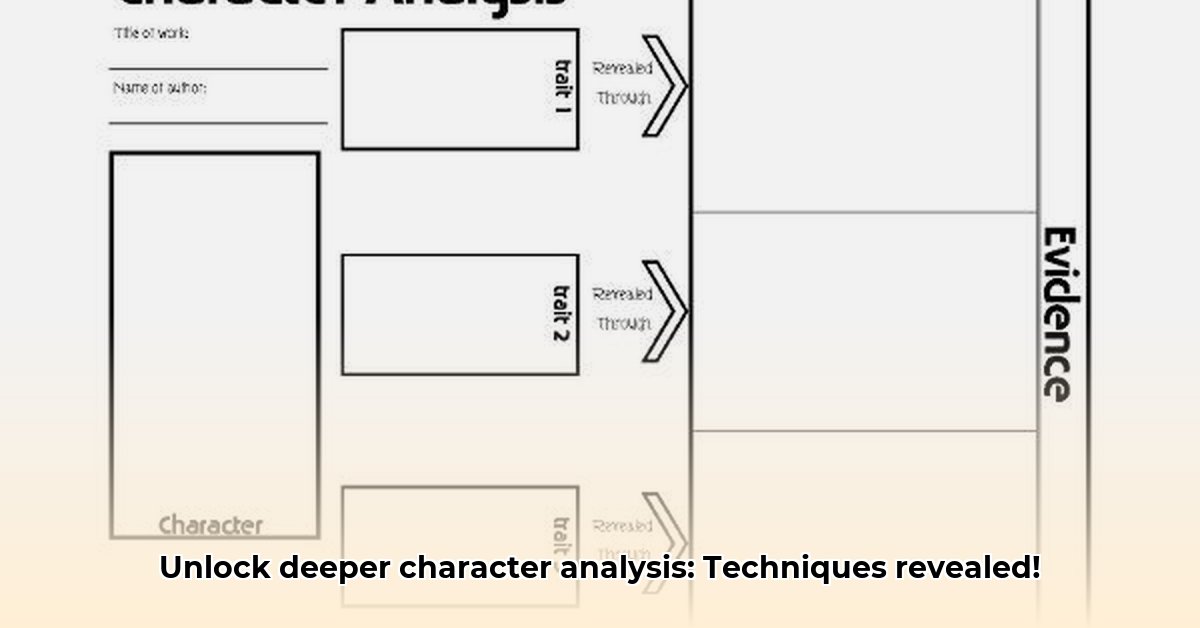
Ready to become a literary detective and unlock the secrets hidden within your favorite characters? This guide will teach you how to perform effective character analysis using simple, yet powerful, graphic organizers. Whether you're a student, teacher, or aspiring writer, these techniques will help you understand stories on a whole new level.
Understanding Character Analysis Charts: Your Literary Toolkit
Think of a character analysis chart as your personal investigative notebook—a place to collect evidence, organize thoughts, and build a compelling case about a character's inner workings. It's like assembling a puzzle; each piece of evidence you uncover helps create a more complete picture. Why is this important? Because a deeper understanding of character equals a deeper appreciation of the story. You'll move beyond simply reading the words to truly experiencing the narrative.
Building Your Character Analysis Chart: A Step-by-Step Guide
Creating a powerful character analysis chart is surprisingly straightforward. Follow these steps to master this crucial literary skill:
Step 1: Choose Your Subject
Select a character that truly fascinates you. This could be the protagonist, antagonist, or even a seemingly minor character with a lasting impact. The choice is entirely yours!
Step 2: Design Your Chart
A simple table is a fantastic starting point:
| Feature | Description/Evidence (with page numbers) | Interpretation & Analysis | Impact on the Story |
|---|---|---|---|
| Physical Traits | (e.g., "He was tall, with piercing eyes" – p. 12) | (e.g., Suggests a strong, perhaps intimidating presence.) | (e.g., Influences how other characters perceive him.) |
| Personality | (e.g., "She was fiercely independent.") | (e.g., Highlights a key personality trait.) | (e.g., Drives her decisions and conflicts.) |
| Key Relationships | (e.g., "His strained relationship with his father.") | (e.g., Reveals a source of conflict or motivation.) | (e.g., Shapes his actions and interactions with others.) |
| Motivations | (e.g., "Driven by a thirst for revenge.") | (e.g., Explains his actions and moral compass.) | (e.g., This motivates the plot's central conflict.) |
| Transformation | (e.g., "He undergoes a significant change.") | (e.g., Shows character development and growth.) | (e.g., Alters his relationships and the story's arc.) |
Step 3: Evidence Gathering
Now for some detective work! Carefully reread the text, noting quotes, descriptions, and actions that support your observations. Include page numbers for easy reference. The more evidence, the stronger your analysis. Remember, strong evidence builds a compelling case.
Step 4: Analysis and Interpretation
Here's where critical thinking comes in. Consider your evidence. What do the character's actions, words, and thoughts reveal? Look for patterns, contradictions, and hidden meanings. Let your imagination guide you, but always ground your interpretations in the text. Do their actions align with their stated beliefs? Are there discrepancies?
Step 5: Connecting Character and Narrative
How does your character influence the broader narrative? How do their actions impact other characters and the story's themes? This requires considering the character's role within the larger context of the story. Does the character act as a catalyst for change, a symbol of a particular theme, or something else entirely?
Beyond the Basic Table: Exploring Different Chart Styles
While tables are effective, explore other visual aids! Mind maps can illustrate character relationships, timelines track character development, and flowcharts can show cause-and-effect relationships between events and motivations. Choose the chart style that best suits your needs and enhances your understanding.
Deepening Your Analysis: Uncovering Hidden Layers
Don't stop at surface-level observations. Ask probing questions:
- What are the character's unspoken desires or fears?
- How has their past shaped their present?
- Do they undergo a transformation? How and why?
- How does the narrator portray them? Is there bias?
These questions will elevate your analysis from simple summary to a nuanced exploration.
Analyzing Complex Character Motivations in Classic Literature
Analyzing complex motivations requires careful examination. Consider the following:
Step 1: Use a chart as your roadmap.
Step 2: Gather evidence from the text: direct statements, actions, dialogue, and even body language.
Step 3: Deconstruct motivations: What drives the character's actions? Are they conscious or subconscious?
Step 4: Chart the character arc: How does the character change (or not) throughout the story?
Step 5: Connect the dots: Use your completed chart to weave together insights into a comprehensive picture of their motivations. How do these motivations contribute to the story's overall meaning?
Step 6: Analyze and Interpret: Consider the author's portrayal. Is it effective? Are the motivations believable within the story's context?
Key Takeaways:
- Master character analysis using charts to understand complex motivations.
- Deconstruct characters' actions to reveal their inner lives.
- Explore how past experiences impact present decisions.
- Use charts to visualize character arcs and transformations.
- Apply these techniques to any literature to deepen your understanding.
Remember, effective character analysis is a journey of discovery, revealing the richness and complexity of characters and their roles within the narrative. By using these techniques and embracing your inner literary detective, you'll gain a deeper appreciation for the stories you read and write.